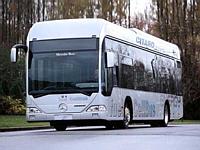Driving Test Period Continues Citaro Bus with Fuel Cell Power System
Stuttgart / Mannheim, The first prototype anywhere in the world of a near production-standard bus with fuel cell technology was presented to its future owners at the end of last year in Vancouver, Canada. The vehicle has now entered the trial drive and production setting phase. The fuel cell powered bus is the first of a limited-production series of 30 Mercedes-Benz Citaro fuel cell urban buses. They were sold in Amsterdam in March last year to the ten European transport operators taking part in the European Fuel Cell Bus Project. The vehicles are due to be delivered in groups of three vehicles to each of the customers over the course of the coming year.
At the presentation in Canada, where extensive test driving was also part of the program, the Mercedes-Benz Citaro with fuel cell drive system put up an impressive showing. In attendance were representatives from the infrastructure companies involved in the European Fuel Cell Bus Project, as well as from the fuel industry and the future owners of the fuel cell buses. There was universal delight at what they saw. The following quotes were typical: "There was very little difference between its driving dynamics and those of our diesel-powered buses," beamed Wolfgang Marahrens, responsible for bus operation at Hamburger Hochbahn AG. "If I close my eyes, I can't tell the difference between this bus and a diesel model - apart from the fact that it makes a lot less noise" (Prof. Jorge Freire de Sousa, member of the Board of Management at Sociedade de Transportes Colectivos do Porto, S.A., in Porto, Portugal).
The Citaro fuel cell powered buses will go into service in the following cities: Amsterdam (Netherlands), Barcelona (Spain), Madrid (Spain), Hamburg (Germany), London (Great Britain), Luxembourg, Porto (Portugal), Stockholm (Sweden), Stuttgart (Germany) and Reykjavik (Iceland).
"The sale of the 30 fuel cell powered buses represents a successful market launch for the new technology. Plus, it is proof of the appeal of fuel cell sys-tems as an environment-friendly and efficient power source of the future for local public transport", explained Wolfgang Diez, Head of the Mercedes-Benz/Setra Bus and Coach business unit of DaimlerChrysler AG. "We are pleased to be the world's first automobile manufacturer to offer its customers the benefits of this pioneering technology for inner-city areas with high levels of emissions. This project will allow the transport operators involved to take on a leading role worldwide and give them the opportunity to experience this innovative technology at work at an early stage, both in the vehicle itself and through the infrastructure."
Both from an environmental and a durability point of view, the fuel cell powered buses are doubly impressive. The buses themselves are emission-free, and the fuel used to power them is set to be produced in the long term largely from renewable energy sources. The Mercedes-Benz Citaro urban regular-service bus with fuel cell drive system is the technological successor to the Nebus (New Electric Bus). This prototype was based on the O 405 low-floor urban regular-service bus and, in 1997, became the first Mercedes-Benz bus with fuel cell technology to take to the streets. Since that first outing, it has gone on to prove its technical capability in different locations around the world.
The twelve-metre long Mercedes-Benz Citaro low-floor solo bus with fuel cell drive system will have a range of some 200 kilometres and can accommodate more than 60 passengers, depending on the individual customer specification. The fuel cell unit with a power output of over 200 kilowatts and the compressed gas cylinders containing hydrogen compressed at 350 bar are located on the roof of the Citaro bus. Maximum speed is up to 80 km/h. The electric motor, transmission, driveshaft and mechanical rear axle are mounted in the rear section of the bus. Three doors without steps and the continuous low-floor area through to the rear ensure a smooth flow of passengers on and off the bus.
After its successful launch in 1997, the Mercedes-Benz Citaro low-floor, regular-service bus range has quickly established itself in the market. The range includes low-floor urban buses, rural-service variants and chassis. Over 4000 Citaro complete buses and chassis have been produced so far. The Mercedes-Benz Citaro is available as a solo bus with a length of 12 m, as a 15-m long three-axle bus or as an articulated bus at 18 m in length. Its underlying technical design makes it an excellent basis for the use of fuel cell technology.



